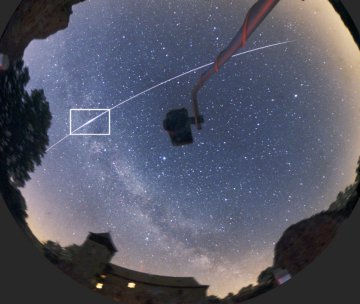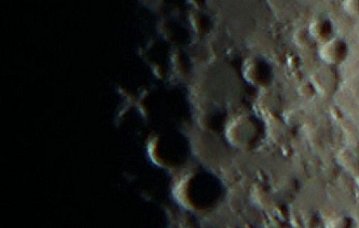| SOUTHERN METEOR SHOWER: Earth is entering a stream of dusty debris from Halley's Comet, the source of the annual eta Aquarid meteor shower. Forecasters expect the shower to peak on Wednesday morning, May 6th, with as many as 85 meteors per hour over the southern hemisphere. Rates in the northern hemisphere will be less, 20 to 30 per hour. The best time to look is during the dark moonless hour before local sunrise. [details and sky maps] SPACE STATION FLARE: Watching the International Space Station (ISS) is more exciting than it used to be. Why? Because now the station flares. Martin Gembec witnessed one of the luminous outbursts on May 2nd during a star party at Litice castle in the Czech Republic. "We were watching a bright flyby of the space station when the ISS surprised us with a big flare in the Milky Way." (continued below) 
"At maximum, the ISS reached magnitude -8," he estimates. That's more than 25 times brighter than Venus or 400 times brighter than Sirius, the brightest star in the sky. "I photographed the flare using my Canon 30D and an all-sky mirror." The ISS flares when sunlight glints off the station's enormous solar arrays. A telescopic view recorded by French amateur astronomer Nicolas Biver on April 28th shows the process in action. A new pair of arrays installed by shuttle astronauts in March has boosted the station's "glint power" and increased the likelihood of flares. Check the Simple Satellite Tracker to find out when the ISS might be flaring over your home town. LUNAR X-MOVIE: On Friday night, May 1st, a luminous X appeared on the Moon. "We saw it easily through our 5-inch telescope," report Enzo De Bernardini and Rodolfo Ferraiuolo of San Rafael, Argentina. Using a digital camera attached to the telescope's eyepiece, they made a movie of the X emerging from the shadows: 
Click to view the movie
What is this "Lunar X"? Once a month when the sun rises over Crater Werner in the Moon's southern hemisphere, sunlight floods the region's high terrain and makes a luminous criss-cross shape. "Observing the X has little or no scientific value. It is a trick of the light. But the effect is striking, and it is exciting to rediscover each month," writes David Chapman in "A Fleeting Vision near Crater Werner" (Journal of the Royal Astronomical Society of Canada, Vol. 101, Issue 2, p.51). The next apparition: May 31, 2009. Mark your calendar with an X.
April 2009 Aurora Gallery
[previous Aprils: 2008, 2007, 2006, 2005, 2004, 2003, 2002]
Explore the Sunspot Cycle | 
